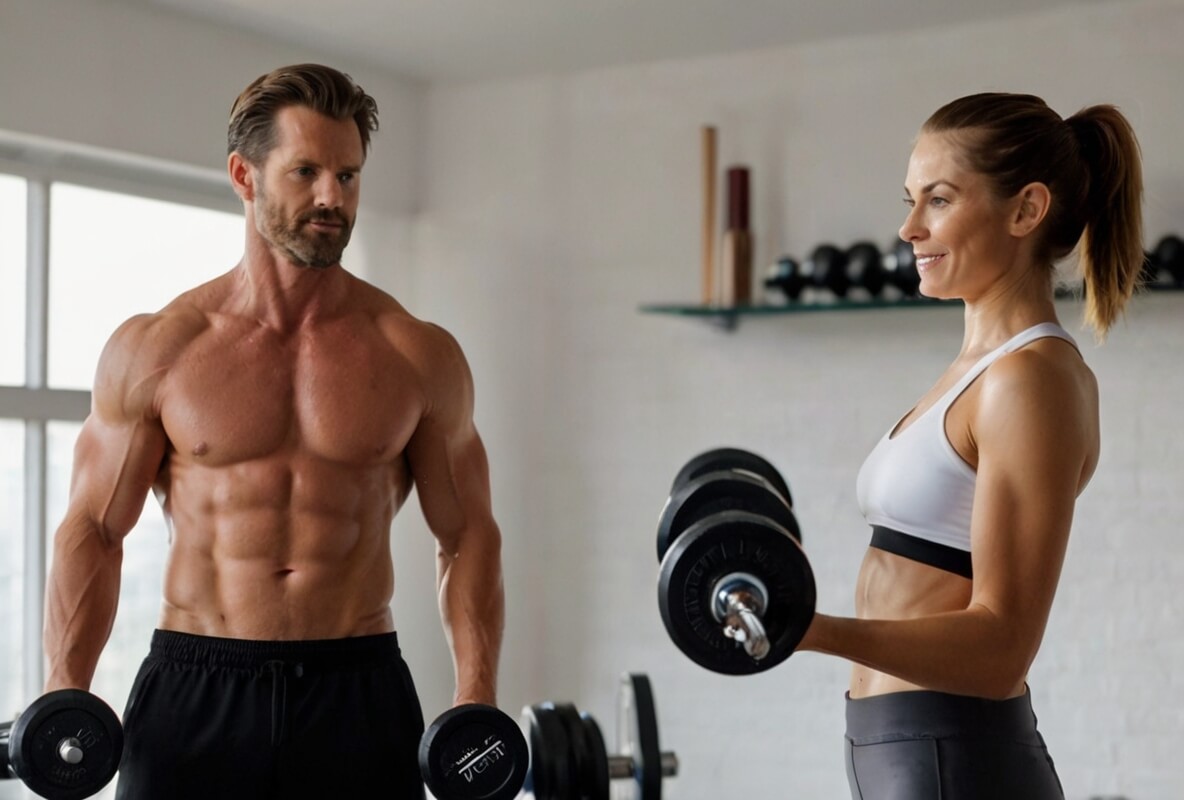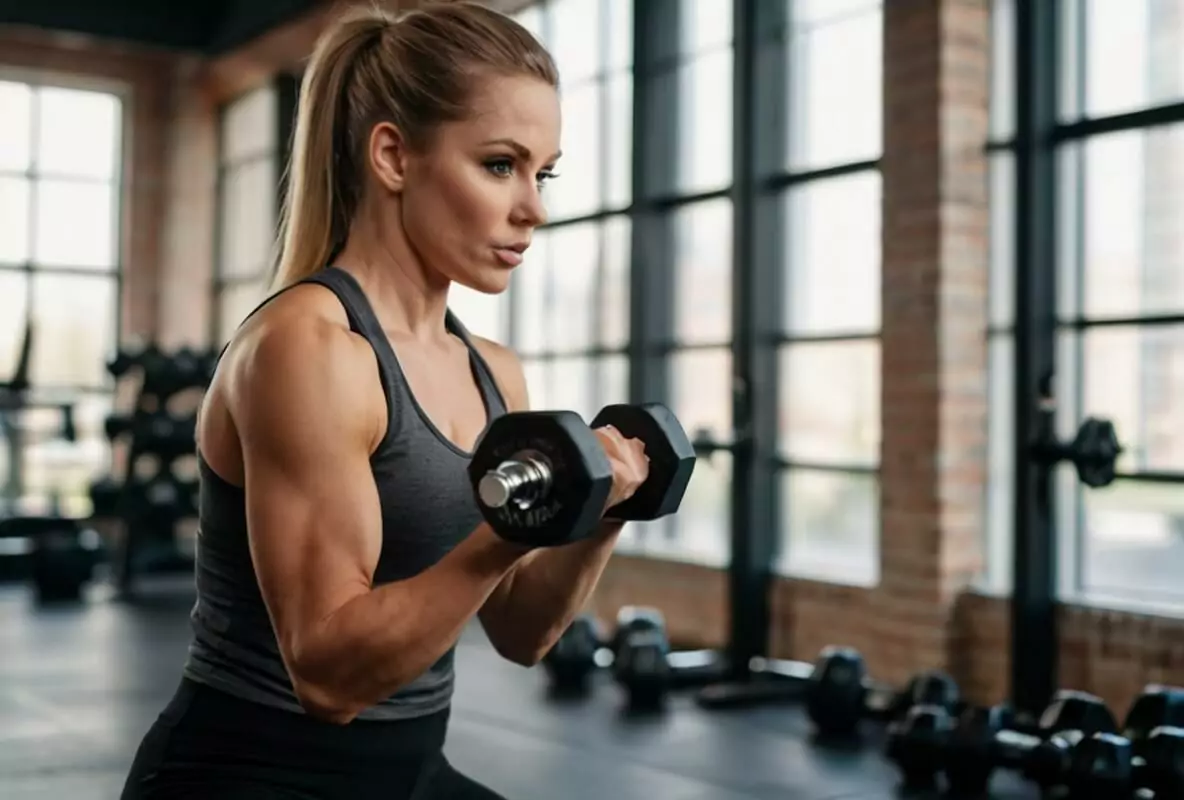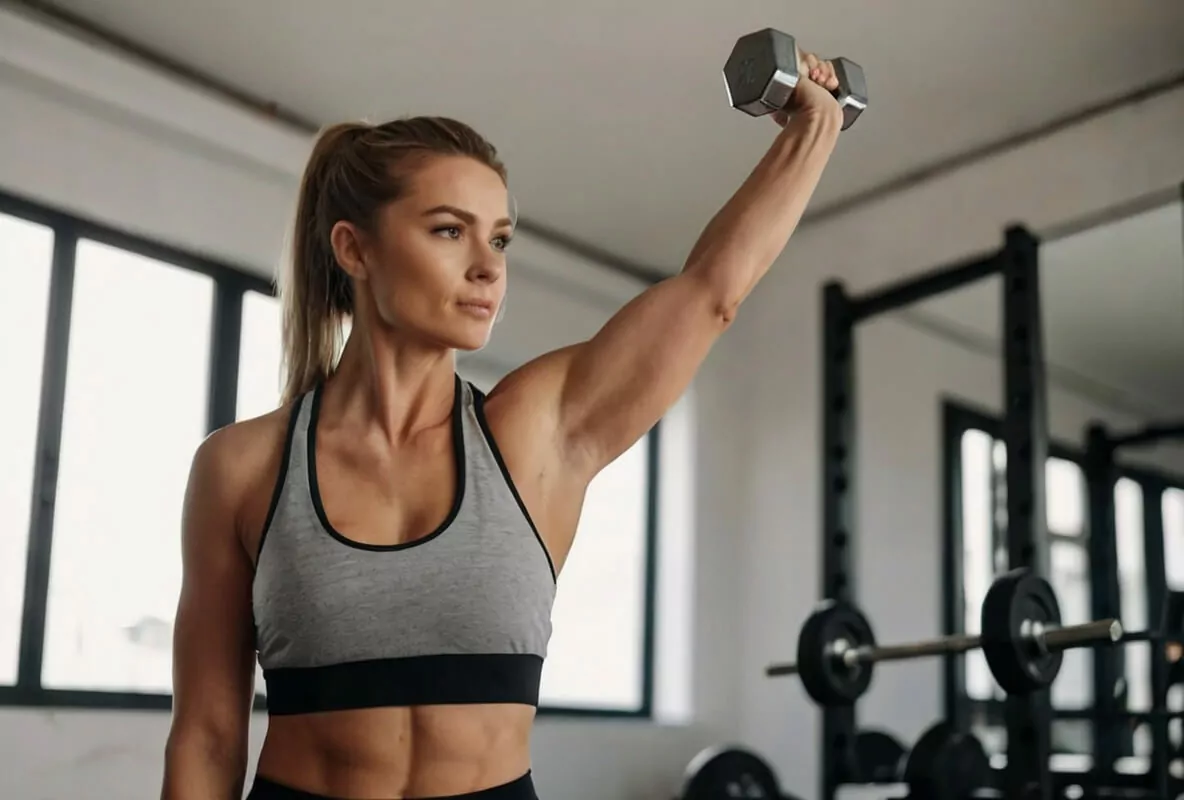The desire for a sculpted physique and improved overall fitness is a common thread that weaves through many of our lives. But between busy schedules and financial constraints, the gym can sometimes feel like an unattainable luxury. Thankfully, there’s a powerful and convenient alternative: the dumbbell workout at home.
This article delves deeper into the world of dumbbell workouts, providing you with the knowledge and tools to craft a personalized and effective routine in the comfort of your own living space.
Want To Get Ripped At Home? This Simple Home Workout Plan Has a 95.4% Success Rate Of Achieving Your Dream Physique! Click Here And See Now
From Beginner to Bodybuilder: A Dumbbell Journey Through Time

Imagine transforming your living room into your own personal fitness haven. Dumbbells become your companions on a journey of strength and definition. This was precisely my experience just a few years ago. The thought of weight training in a crowded gym filled me with apprehension. However, the desire to build muscle and improve my fitness fueled my exploration of at-home workout options.
Dumbbell workouts became my saving grace. With just a set of dumbbells, I could create a challenging and versatile program that fit seamlessly into my schedule. Within weeks, I noticed a significant difference in my strength, endurance, and overall physique. This journey, fueled by convenience and effectiveness, ignited a passion for fitness that continues to this day.
The Science Behind the Sweat: How Dumbbells Work Their Magic

Dumbbell workouts fall under the umbrella of strength training, a form of exercise that utilizes resistance to build muscle mass and improve strength. Here’s a breakdown of the magic that happens when you lift those dumbbells:
Muscle Breakdown and Repair: During strength training exercises, microscopic tears occur in your muscle fibers. This controlled damage triggers a repair process, leading to the growth of new, stronger muscle tissue.
Metabolic Boost: Muscle is metabolically active tissue, meaning it burns calories even at rest. Building muscle through dumbbell workouts increases your basal metabolic rate (BMR), the number of calories your body burns at rest. This translates to more efficient calorie burning throughout the day.
Improved Bone Density: Strength training, including dumbbell exercises, helps stimulate bone formation and increase bone density. This is crucial for maintaining strong bones and reducing the risk of osteoporosis later in life.
Enhanced Balance and Coordination: Dumbbell exercises often require coordinated movements across multiple joints. Regularly performing these exercises improves your balance and coordination, leading to better overall movement efficiency and a reduced risk of falls.
Mental Toughness and Confidence: Overcoming the physical challenges presented by dumbbell workouts fosters mental resilience and a sense of accomplishment. Witnessing your own progress can significantly boost your confidence and self-esteem.
Building a Strong Foundation: Essential Tips for Effective Dumbbell Workouts

Now that you’re armed with the knowledge of the benefits dumbbell workouts offer, let’s explore some crucial tips for making the most of your at-home routine:
Choosing the Perfect Pair:
The weight of your dumbbells significantly impacts the effectiveness of your workout. Here’s how to select the right dumbbells for you:
- Beginner: Start with lighter weights that allow you to complete 12-15 repetitions of an exercise with good form before reaching fatigue.
- Intermediate: Once you can comfortably perform 12-15 repetitions with your current weights, it’s time to increase the challenge. Move up to weights that allow for 8-12 repetitions before fatigue.
- Advanced: For those seeking serious muscle growth, choose weights that challenge you to complete 6-8 repetitions with proper form.
Form is Paramount:
Using proper form during dumbbell exercises is essential for maximizing results and preventing injuries. Here are some general guidelines:
- Maintain a neutral spine: Keep your back straight and core engaged throughout most exercises. Avoid arching your back or rounding your shoulders.
- Controlled movements: Focus on controlled and deliberate movements for both the lifting and lowering phases of each exercise.
- Full range of motion: Move your joints through their full range of motion without compromising form.
- Mind-muscle connection: Focus on engaging the targeted muscle group with each repetition.
Listen to Your Body:
Rest and recovery are vital for muscle growth and preventing injuries. Don’t hesitate to take breaks when needed. If you experience sharp pain, stop the exercise and consult a healthcare professional.
Warm-Up and Cool-Down:
A proper warm-up prepares your muscles for exercise and reduces the risk of injury. Five to ten minutes of light cardio, followed by dynamic stretches like arm circles and leg swings, are excellent ways to get your body ready. Similarly, a cool-down with static stretches aids in muscle recovery and improves flexibility.
The Art of Programming: Crafting Your Personalized Dumbbell Workout
Building a Balanced Routine:
An effective dumbbell workout routine should target all major muscle groups. This ensures balanced development and helps prevent muscle imbalances that can lead to injuries. Here’s a breakdown of the key muscle groups and some basic dumbbell exercises to target them:
Upper Body:
- Chest: Dumbbell press, chest flyes
- Back: Dumbbell rows, bent-over dumbbell raises
- Shoulders: Dumbbell overhead press, lateral raises
- Biceps: Bicep curls (hammer curls for targeted bicep development)
- Triceps: Tricep extensions, overhead tricep extensions
Lower Body:
- Quads: Squats, lunges
- Hamstrings: Romanian deadlifts, hamstring curls (can be performed with dumbbells or a resistance band)
- Glutes: Glute bridges, Bulgarian split squats
- Calves: Calf raises (can be performed with dumbbells or bodyweight)
Frequency and Progression:
Aim for 2-3 strength training sessions per week, allowing at least one rest day between workouts. This allows your muscles adequate time to recover and rebuild. As you get stronger, consider incorporating progressive overload, a principle where you gradually increase the difficulty of your workouts over time. This can be achieved by increasing the weight of your dumbbells, the number of sets or repetitions performed, or reducing your rest periods between sets.
Sample 30-Minute Dumbbell Workout:
This sample workout routine provides a blueprint for a well-rounded, 30-minute dumbbell workout at home. Remember to modify the exercises, sets, reps, and rest periods to suit your fitness level and goals.
Warm-Up (5 Minutes):
- Light cardio (jumping jacks, jogging in place)
- Arm circles (forward and backward)
- Leg swings (forward and backward)
- Torso twists
Upper Body (12 Minutes):
Circuit 1 (3 sets of 10-12 repetitions per exercise with 30 seconds rest between exercises):
- Dumbbell Overhead Press: Stand with feet shoulder-width apart, core engaged, and hold a dumbbell in each hand at shoulder height, palms facing forward. Press the dumbbells directly overhead until your arms are straight. Lower the dumbbells back down with control to shoulder height. (Targets shoulders, triceps)
- Dumbbell Row: Stand with feet shoulder-width apart, knees slightly bent, and hold a dumbbell in each hand with palms facing inward. Hinge at your hips and lean forward, keeping your back straight and core engaged. Row the dumbbells towards your sides, squeezing your shoulder blades together at the top. Slowly lower the dumbbells back down with control. (Targets back muscles)
- Dumbbell Bicep Curl: Stand with feet shoulder-width apart and hold a dumbbell in each hand at your sides, palms facing forward. Curl the dumbbells up towards your shoulders, keeping your upper arms stationary and squeezing your biceps at the top. Slowly lower the dumbbells back down to the starting position. (Targets biceps)
Circuit 2 (3 sets of 10-12 repetitions per exercise with 30 seconds rest between exercises):
- Dumbbell Chest Press: Lie flat on the floor (or a bench if available) with knees bent and feet flat on the ground. Hold a dumbbell in each hand at shoulder height, palms facing each other. Press the dumbbells upwards until your arms are straight, then lower them back down with control to shoulder height. (Targets chest, triceps)
- Dumbbell Lateral Raise: Stand with feet shoulder-width apart and hold a dumbbell in each hand at your sides, palms facing inward. Raise your arms out to the sides until they are parallel to the floor, keeping a slight bend in your elbows. Lower the dumbbells back down with control to the starting position. (Targets shoulders)
- Dumbbell Tricep Extension: Stand with feet shoulder-width apart and hold a dumbbell in each hand behind your head, elbows bent and close to your head. Extend your arms back, straightening your elbows without locking them. Lower the dumbbells back down with control to the starting position. (Targets triceps)
Lower Body (8 Minutes):
Superset 1 (3 sets of 10-12 repetitions per exercise with minimal rest between exercises):
- Squats: Stand with feet shoulder-width apart, toes slightly pointed outward. Hold dumbbells at shoulder height, palms facing forward. Engage your core and lower your body as if sitting back into a chair, keeping your back straight and knees tracking over your toes.
- Dumbbell Romanian Deadlift: Without resting, immediately hinge at your hips and lower the dumbbells towards the floor, maintaining a slight bend in your knees and keeping your back straight and core engaged. Stop when you feel a stretch in your hamstrings, then squeeze your glutes to return to the starting position for the squat. (Targets hamstrings, glutes, lower back)
Superset 2 (3 sets of 10-12 repetitions per exercise with minimal rest between exercises):
- Dumbbell Lunges: Stand with feet hip-width apart, holding dumbbells at your sides. Step forward with one leg, lowering your body until both knees are bent at 90-degree angles. Ensure your front knee doesn’t track past your toes, and keep your back upright. Push through your front heel to return to the starting position and repeat with the other leg. (Targets quads, glutes, hamstrings)
- Dumbbell Bulgarian Split Squat: Find a bench or sturdy chair. Stand with one foot behind you placed on the bench, holding dumbbells at your sides. Lower your body by bending your front knee until it reaches a 90-degree angle. Push through your front heel to return to the starting position and repeat with the other leg. (Targets quads, glutes)
Core (5 Minutes):
Circuit 3 (3 sets of 15-20 repetitions per exercise with 30 seconds rest between exercises):
- Russian Twist: Sit on the floor with knees bent and feet flat on the ground. Lean back slightly, engaging your core, and twist your torso from side to side, holding dumbbells in each hand for added challenge. (Targets obliques)
- Plank: Get into a high plank position with forearms on the floor and body in a straight line from head to heels. Engage your core and glutes to maintain proper form. Hold for 30 seconds, then rest. Repeat for 2-3 sets. (Targets entire core)
- Side Plank (each side): Lie on your side with your elbow directly under your shoulder and legs stacked on top of each other. Lift your hips off the ground, forming a straight line from head to heels. Hold for 30 seconds, then switch sides and repeat. (Targets obliques)
Cool-Down (5 Minutes):
- Light cardio (walking in place, arm circles)
- Static stretches (hold each stretch for 30 seconds):
- Hamstring stretch
- Quad stretch
- Chest stretch
- Tricep stretch
- Bicep stretch
- Calf stretch
Remember: This is just a sample workout routine. Feel free to adjust the exercises, sets, repetitions, and rest periods based on your fitness level and goals. There are many excellent dumbbell exercises you can incorporate into your routine. You can find a wealth of information and exercise variations online [dumbbell exercises at home ON verywellfit.com].
Beyond the Iron: Your Journey to Fitness Success
Building a sustainable fitness routine extends beyond just the workouts themselves. Here are some additional tips to maximize your results and stay motivated on your dumbbell workout journey:
- Nutrition is Key: A healthy diet fuels your body for optimal performance and recovery. Focus on consuming whole, unprocessed foods that provide your body with the essential nutrients it needs to thrive.
- Hydration is Essential: Drink plenty of water throughout the day, especially before, during, and after your workouts. Proper hydration ensures your body functions at its best and helps prevent dehydration.
- Prioritize Sleep: Getting enough quality sleep allows your body to repair and rebuild muscle tissue. Aim for 7-8 hours of sleep per night.
- Track Your Progress: Monitoring your progress can be a powerful motivator. Keep track of the weights you lift, the number of sets and repetitions you perform, and any changes you notice in your physique or strength.
- Find a Workout Buddy: Having someone to work out with can add a layer of accountability and enjoyment to your workouts. Consider teaming up with a friend or family member who shares your fitness goals.
- Celebrate Your Achievements: Take the time to acknowledge your progress, no matter how big or small. This will help you stay motivated and keep pushing yourself towards your goals.
Embrace the Journey: Building a Supportive Fitness Community
The fitness world can feel intimidating, especially for beginners. But remember, you’re not alone on this journey! Here are some ways to connect with others who share your passion for dumbbell workouts:
- Online Fitness Communities: Numerous online forums and social media groups cater to dumbbell enthusiasts. These communities provide a platform to ask questions, share experiences, and find encouragement from others on a similar fitness path.
- Fitness Apps and Online Programs: Many fitness apps and online programs offer dumbbell workout routines, instructional videos, and progress tracking tools. These resources can be a valuable source of guidance and motivation.
- Hire a Virtual Trainer: Consider working with a certified personal trainer who specializes in online coaching. A virtual trainer can create personalized workout plans, provide form corrections, and offer ongoing support to help you achieve your fitness goals.
Remember, consistency is key to success with dumbbell workouts. Don’t get discouraged if you don’t see results overnight. Focus on making gradual improvements, celebrate your wins, and enjoy the process of building a stronger, healthier you.
The Final Pump: Unleash Your Inner Fitness Champion

The world of dumbbell workouts offers a convenient, effective, and empowering way to transform your physique and improve your overall fitness. With dedication and the knowledge provided in this guide, you have the tools to embark on a journey of strength, confidence, and self-discovery. So, grab your dumbbells, find your space, and get ready to unleash your inner fitness champion!
We encourage you to share your experiences with dumbbell workouts at home in the comments below! What challenges have you faced? What are your favorite exercises? Let’s build a supportive community where we can learn from each other and celebrate our fitness victories together!
Follow our social networks facebook, pinterest and see more tips
